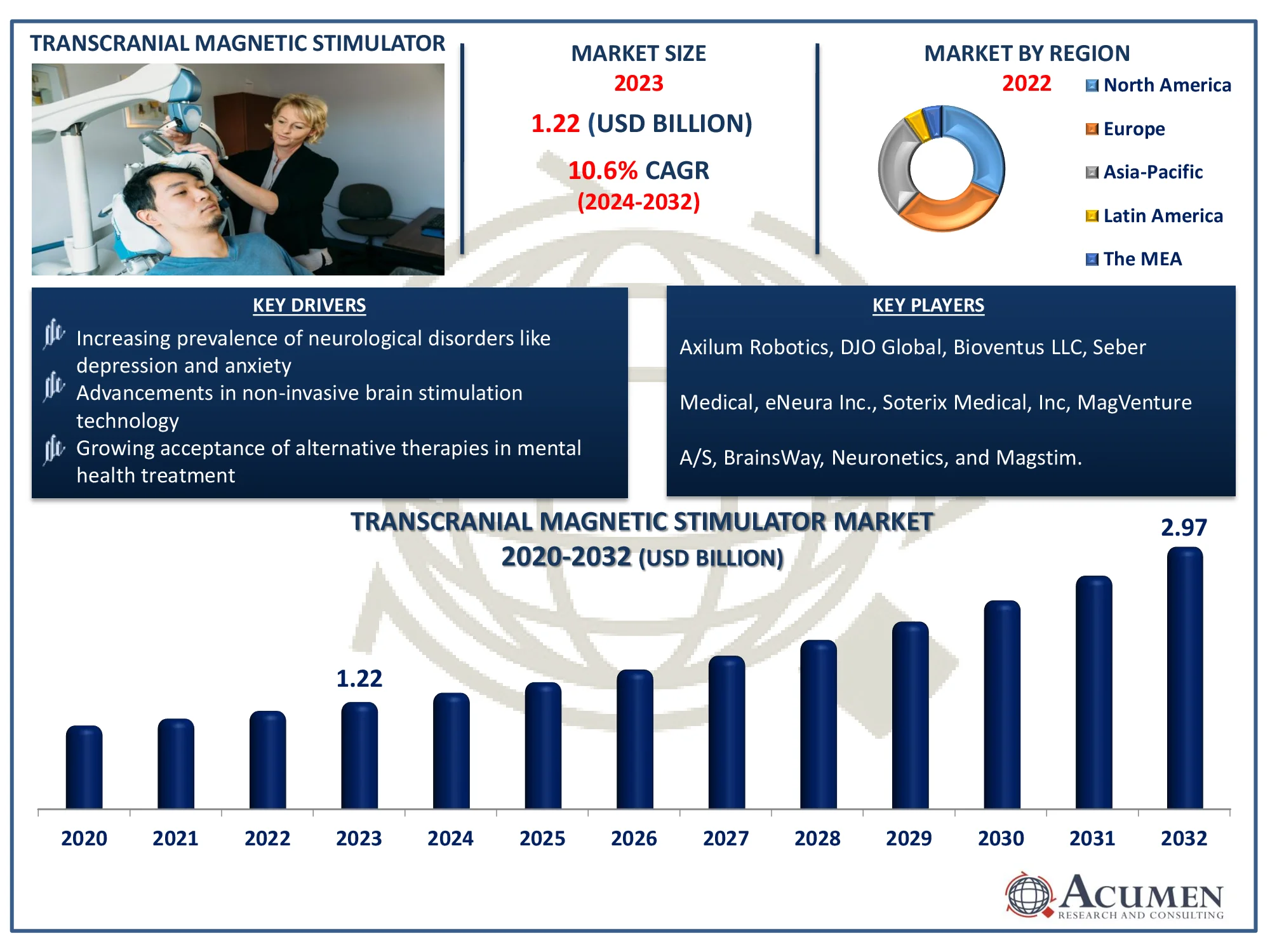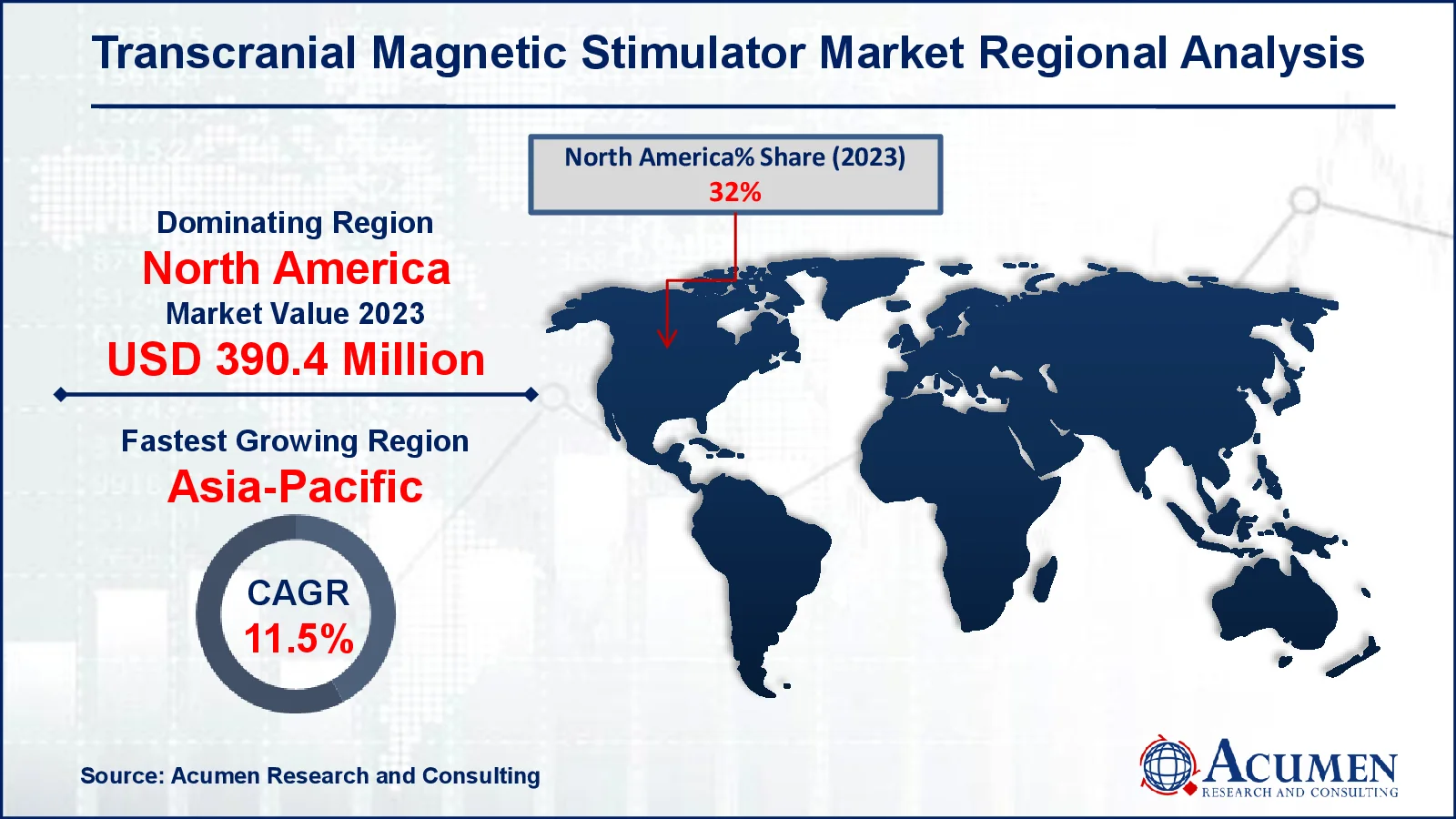Transcranial Magnetic Stimulator Market Size - Global Industry, Share, Analysis, Trends and Forecast 2024 - 2032
Published :
Report ID:
Pages :
Format :
Transcranial Magnetic Stimulator Market Size - Global Industry, Share, Analysis, Trends and Forecast 2024 - 2032
Report Coverage
- Industry Dynamics
- Market Size and Forecast Data
- Segment Analysis
- Competitive Landscape
- Regional Analysis with a Niche Focus on Country-Level Data
- High Level Analysis - Porter's, PESTEL, Value Chain, etc.
- Company Profiles of Key Players
- Option to Customize the Report As Per Your Specific Need
Request Sample Report
The Global Transcranial Magnetic Stimulator Market Size accounted for USD 1.22 Billion in 2023 and is estimated to achieve a market size of USD 2.97 Billion by 2032 growing at a CAGR of 10.6% from 2024 to 2032.
Transcranial Magnetic Stimulator Market Highlights
- The global transcranial magnetic stimulator market is projected to reach USD 2.97 billion by 2032, with a CAGR of 10.6% from 2024 to 2032
- In 2023, the North American transcranial magnetic stimulator market held a value of approximately USD 390.4 million
- The Asia-Pacific region is expected to grow at a CAGR of over 11.5% from 2024 to 2032
- The repetitive transcranial magnetic stimulation type accounted for 39% of the market share in 2023
- The adults age group sub-segment captured 58% of the market share in 2023
- Alzheimer’s disease applications accounting for 42% market share in transcranial magnetic stimulator market
- Rising adoption in neurological research, and technological advancements enhancing treatment precision and accessibility is the transcranial magnetic stimulator market trend that fuels the industry demand

Transcranial magnetic stimulators are commonly utilized in the treatment of brain and neurological disorders. Transcranial magnetic stimulators are a non-invasive method that delivers magnetic pulses to the brain, reducing chronic pain and stimulating nerve cells. The demand for transcranial magnetic stimulators has expanded dramatically in recent years due to the rising prevalence of numerous neurological illnesses. According to the National Library of Medicine, the present global increase in the incidence of various neurological illnesses may be connected to population expansion, population ageing, increasing life expectancy, and increased exposure to associated risk factors.
Global Transcranial Magnetic Stimulator Market Dynamics
Market Drivers
- Increasing prevalence of neurological disorders like depression and anxiety
- Advancements in non-invasive brain stimulation technology
- Growing acceptance of alternative therapies in mental health treatment
Market Restraints
- High cost of transcranial magnetic stimulation (TMS) devices and treatment sessions
- Limited insurance coverage and reimbursement in some regions
- Potential side effects and contraindications limiting patient eligibility
Market Opportunities
- Expanding applications in conditions beyond depression, such as Parkinson's and Alzheimer's
- Rising investment in mental health solutions and therapies
- Technological innovations enabling portable and more user-friendly TMS devices
Transcranial Magnetic Stimulator Market Report Coverage
| Market | Transcranial Magnetic Stimulator Market |
| Transcranial Magnetic Stimulator Market Size 2022 |
USD 1.22 Billion |
| Transcranial Magnetic Stimulator Market Forecast 2032 | USD 2.97 Billion |
| Transcranial Magnetic Stimulator Market CAGR During 2023 - 2032 | 6.6% |
| Transcranial Magnetic Stimulator Market Analysis Period | 2020 - 2032 |
| Transcranial Magnetic Stimulator Market Base Year |
2022 |
| Transcranial Magnetic Stimulator Market Forecast Data | 2023 - 2032 |
| Segments Covered | By Type, By Age Group, By Application, And By Geography |
| Regional Scope | North America, Europe, Asia Pacific, Latin America, and Middle East & Africa |
| Key Companies Profiled | Axilum Robotics, DJO Global, Bioventus LLC, Seber Medical, eNeura Inc., Soterix Medical, Inc, MagVenture A/S, BrainsWay, Neuronetics, and Magstim. |
| Report Coverage |
Market Trends, Drivers, Restraints, Competitive Analysis, Player Profiling, Covid-19 Analysis, Regulation Analysis |
Transcranial Magnetic Stimulator Market Insights
The transcranial magnetic stimulator market has grown due to increased health awareness, expanding population, and changing lifestyles. For instance, according to Mental Health UK, Mental Health Awareness Week 2024 was from Monday, May 13 to Sunday, May 19. The Mental Health Foundation chose the topic "Movement: Moving for Our Mental Health." This year, they encouraged people to choose something that move both body and mind. The next Mental Health Awareness Week will occur in 2025. This growing awareness about health drives demand for industry.
Many government and commercial organizations are attempting to educate the public about the different applications and benefits of the transcranial magnetic stimulator, which has aided the growth of the transcranial magnetic stimulator market. For instance, on August 23, 2023, the World Trade Center Health Program has updated its coverage for repeated transcranial magnetic stimulation (rTMS) treatment. Repetitive transcranial magnetic stimulation (rTMS) is used to treat Major Depressive Disorder (MDD) in the absence of psychosis. The coverage for rTMS has been enhanced to provide more flexibility in treatment schedule. By expanding treatment schedule flexibility, the WTC Health Program hopes to make rTMS more accessible to people who could benefit from it, potentially raising awareness. This transition by a government-sponsored initiative may reflect a larger trend in which both government and private health organizations collaborate to educate the public and healthcare practitioners about the possible applications and benefits of rTMS.
On the other hand, limited penetration of transcranial magnetic stimulators in developing Asian and African countries, as well as expensive prices, may restrict the market's growth. However, technological innovations enabling portable and more user-friendly TMS devices becomes opportunity for transcranial magnetic stimulator industry. For instance, according to National Institute of Health (NIH), TMS technology has undergone significant advancements, including improved signal generators, coils, positioning devices, and semi-automatic software for better therapy planning. New stimulator designs, advances in coil functioning and placement, and algorithms to improve stimulation precision are among the research highlights. These advancements improve TMS therapies' accuracy, efficacy, and adaptability for patients.
Transcranial Magnetic Stimulator Market Segmentation
The worldwide market for transcranial magnetic stimulator is split based on type, age group, application, and geography.
Transcranial Magnetic Stimulator (TMS) Market By Type
- Deep Transcranial Magnetic Stimulation
- Repetitive Transcranial Magnetic Stimulation
- Others
According to the transcranial magnetic stimulator industry analysis, repetitive transcranial magnetic stimulation (rTMS) is the most popular form in the market, owing to its established success in treating a variety of neurological and psychiatric problems. rTMS works by providing a sequence of magnetic pulses to specific brain regions, which can boost neuronal activity and improve mood and cognitive function. As research continues to prove its efficacy, rTMS is likely to maintain its top position and broaden its applications to a variety of illnesses.
Transcranial Magnetic Stimulator (TMS) Market By Age Group
- Adults
- Children
According to the transcranial magnetic stimulator industry analysis, adults age group dominates market, owing to the higher prevalence of neurological and mental illnesses such as depression and anxiety. This age group frequently seeks out novel therapeutic options, especially for illnesses that have not responded to conventional medicines. Adults are also more inclined to seek mental health treatment, and healthcare experts frequently recommend TMS as a realistic option. As individuals become more aware of mental health issues, demand for TMS is projected to climb, bolstering its market position.
Transcranial Magnetic Stimulator (TMS) Market By Application
- Alzheimer’s Disease
- Depression
- Parkinson’s Disease
- Epilepsy
- Others
According to the transcranial magnetic stimulator market forecast, Alzheimer's disease is the most common application in the market, owing to the increasing prevalence of this neurodegenerative disorder worldwide. TMS provides a non-invasive way for potentially improving cognitive function and slowing disease progression, making it a therapeutic option for both patients and healthcare practitioners. The rising amount of studies demonstrating TMS's effectiveness in relieving Alzheimer's symptoms has accelerated its use in therapeutic settings. As the world's population ages and the demand for Alzheimer's medicines grow, TMS plays important role in industry.
Transcranial Magnetic Stimulator Market Regional Outlook
North America
- U.S.
- Canada
Europe
- U.K.
- Germany
- France
- Spain
- Rest of Europe
Asia-Pacific
- India
- Japan
- China
- Australia
- South Korea
- Rest of Asia-Pacific
Latin America
- Brazil
- Mexico
- Rest of Latin America
The Middle East & Africa
- South Africa
- GCC Countries
- Rest of the Middle East & Africa (ME&A)

Transcranial Magnetic Stimulator Market Regional Analysis
For several reasons, North America held largest market share throughout the forecast period due to the large number of patients suffering from various neurological illnesses, the growing elderly population, and the well-developed economy. Furthermore, the increasing number of surgeries, combined with high healthcare spending, has aided the expansion of the North America transcranial magnetic stimulator market globally. The United States dominates the North American transcranial magnetic stimulator market.
Asia-Pacific is predicted to be the fastest expanding market for transcranial magnetic stimulators because to the large number of people suffering from neurological illnesses, and lifestyle factors such as diabetes play a significant role in this region. The presence of a quickly developing economy, rising government backing, and increased healthcare spending have all contributed to the expansion of the transcranial magnetic stimulator market in Asia Pacific. India and China dominate the Asia-Pacific transcranial magnetic stimulator market due to increased government support and increased consumer spending power.
Europe is predicted to have the notable market for transcranial magnetic stimulators worldwide. Adoption of sophisticated devices and treatment approaches, widespread knowledge, and a large patient pool are the primary drivers of the transcranial magnetic stimulator industry. Favorable government assistance and a degrading lifestyle have aided the transcranial magnetic stimulator market expansion.
Transcranial Magnetic Stimulator Market Players
Some of the top transcranial magnetic stimulator companies offered in our report includes Axilum Robotics, DJO Global, Bioventus LLC, Seber Medical, eNeura Inc., Soterix Medical, Inc, MagVenture A/S, BrainsWay, Neuronetics, and Magstim.
Frequently Asked Questions
How big is the transcranial magnetic stimulator market?
The transcranial magnetic stimulator market size was valued at USD 1.22 billion in 2023.
What is the CAGR of the global transcranial magnetic stimulator market from 2024 to 2032?
The CAGR of transcranial magnetic stimulator is 10.6% during the analysis period of 2024 to 2032.
Which are the key players in the transcranial magnetic stimulator market?
The key players operating in the global market are including Axilum Robotics, DJO Global, Bioventus LLC, Seber Medical, eNeura Inc., Soterix Medical, Inc, MagVenture A/S, BrainsWay, Neuronetics, and Magstim
Which region dominated the global transcranial magnetic stimulator market share?
North America held the dominating position in transcranial magnetic stimulator industry during the analysis period of 2024 to 2032.
Which region registered fastest CAGR from 2024 to 2032?
Asia-Pacific region exhibited fastest growing CAGR for market of transcranial magnetic stimulator during the analysis period of 2024 to 2032.
What are the current trends and dynamics in the global transcranial magnetic stimulator industry?
The current trends and dynamics in the transcranial magnetic stimulator industry include increasing prevalence of neurological disorders like depression and anxiety, advancements in non-invasive brain stimulation technology, and growing acceptance of alternative therapies in mental health treatment.
Which type held the maximum share in 2023?
The repetitive transcranial magnetic stimulation type held the maximum share of the transcranial magnetic stimulator industry.



